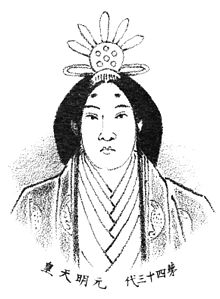Gemmei
Empress Gemmei ( Japanese 元 明天 皇, Gemmei-tennō also Gemmyō ; * 661 ; † December 29, 721 ; reign: 707-715) was, according to traditional counting, the 43rd Tennō of Japan and the fourth woman in this office.
Life
She was a daughter of Emperor Tenji and married Crown Prince Kusakabe no Miko (posthumously: Hinameshi ), the son of Emperor Temmu and Empress Jitō and at the same time her cousin and nephew. Her proper name was Ahe no hime miko (Princess Ahe). After her son Emperor Mommu died, she ascended the throne in order to secure the succession of her grandson Prince Obito (Emperor Shōmu ). After her accession to the throne in 707 (in the 7th month, 17th day), she set up the jutō toneri ryō, a personal guard for herself and Prince Obito .
On the occasion of copper finds, “Wadō” (和 銅 = 'Japanese copper') was chosen as the Nengō (era name) of the Gemmeis era beginning on January 11, 708. The copper coins (wadō-sen) produced in a newly established mint from 708 are considered the first coins minted in Japan (see Japanese monetary history ).
In 710 she moved the capital from Fujiwara-kyō (today: Kashihara ) to Heijō-kyō (today: Nara ), which gave the Nara period its name. She was mainly responsible for completing the Kojiki in 712 , which her father-in-law Emperor Temmu had commissioned in 680, but which was not completed until his death in 686.
Empress Gemmei sponsored the politicians Fujiwara no Fuhito and Prince Nagaya . As early as 715 she abdicated in favor of Mommu's sister Genshō . Shōmu later succeeded Genshō.
See also
- to the state organization: Ritsuryō
- on the historical era: Nara period
Web links
| predecessor | government office | successor |
|---|---|---|
| Mommu |
Empress of Japan 707–715 |
Genshō |
| personal data | |
|---|---|
| SURNAME | Gemmei |
| ALTERNATIVE NAMES | Genmei; 元 明天 皇 (Japanese); Ahe (proper name) |
| BRIEF DESCRIPTION | 43rd Tennō of Japan (707-715) |
| BIRTH DATE | 661 |
| DATE OF DEATH | December 29, 721 |
